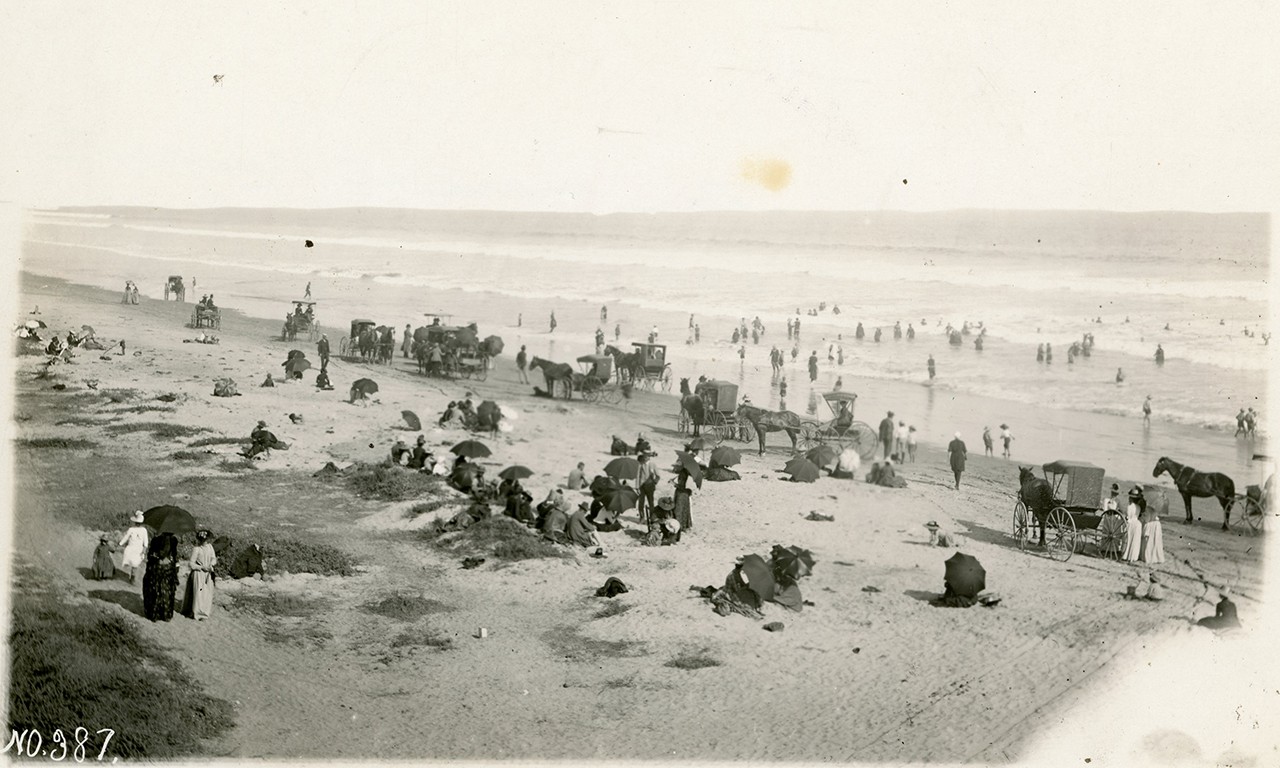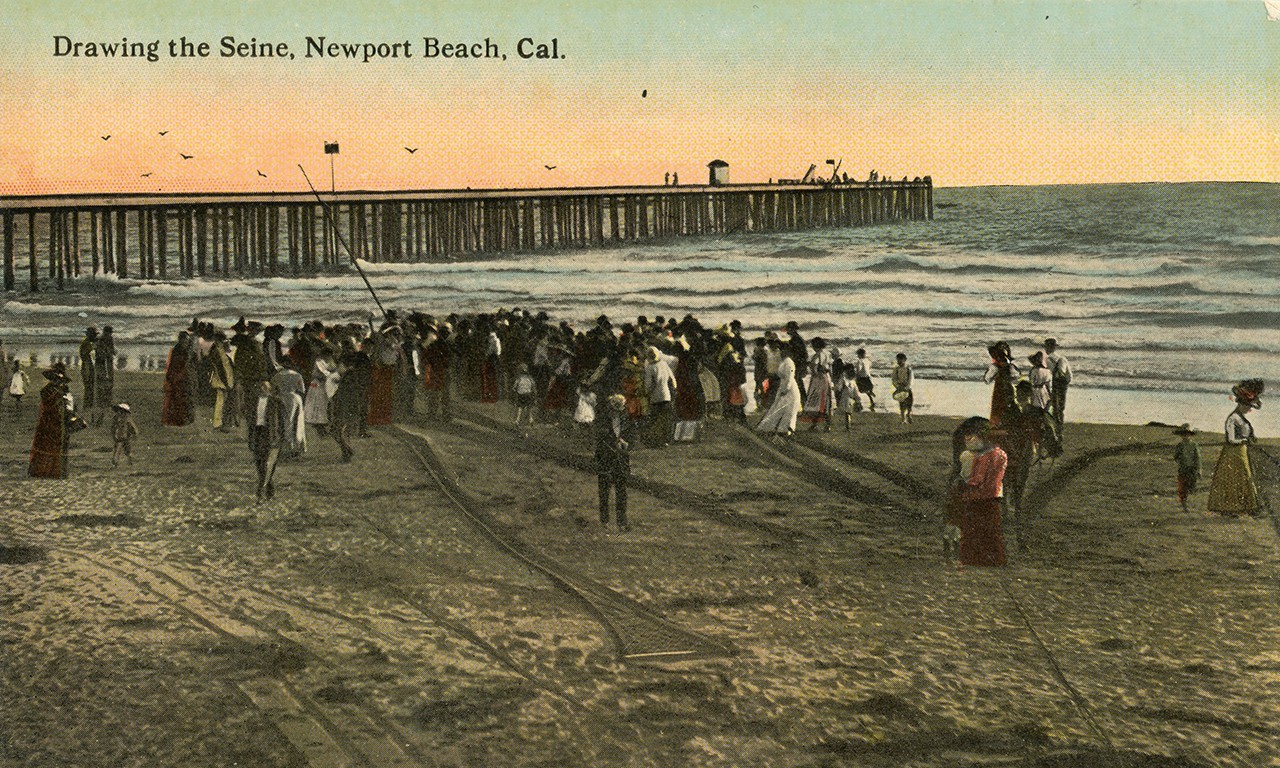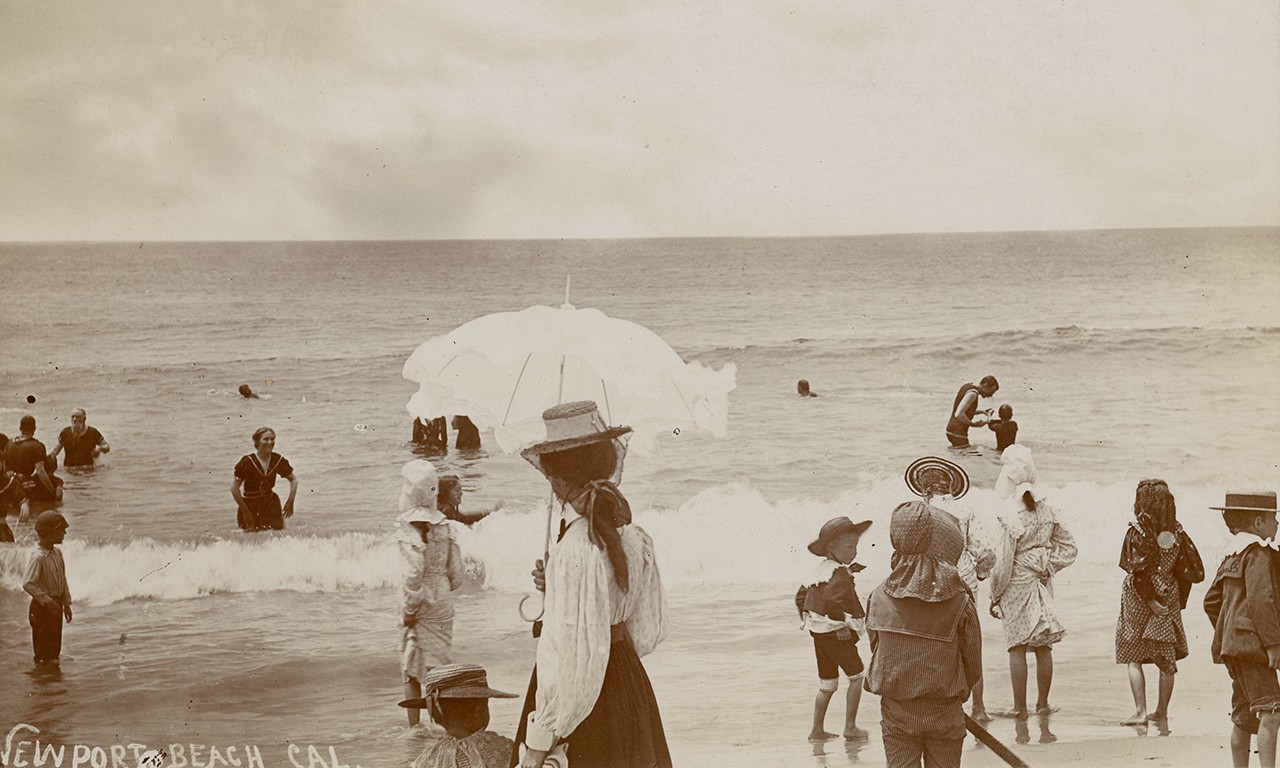 |
Picnic on the Beach, 1880-1899
Newport Beach, California
Photographic print; 5 3/4 x 6 3/4 in.
6964B
Terry E. Stephenson Collection |
Where We Would Rather Be
It is the height of summer and though many of us would enjoy a typical beach day spent with friends or family, social distancing and other precautions taken for this year’s pandemic have thrown a wrench in those plans. Loosely following our Father’s Day post on county sports, today’s post looks at the history of the beaches in the county through the lens of some of the photographs, ephemera, and paintings in the Bowers Collections.
 |
Drawing the Seine, early 20th Century
Newport Beach, California
Photographic print; 3 1/2 x 5 1/2 in.
38660.1
Bower Museum Collections |
Sand History Coarse
Recreational beachgoing in modern-day Orange County long predates countyhood; even written accounts begin around 1857 with the creation of the Anaheim Landing. As a small port for the Santa Ana Valley, the only real shortcoming of this spot was an abundance of stingarees which—though not fatal—were quite a nuisance. As more and more settlers moved to the area, traffic to the beach continued to grow, with many picking up to move to the ocean during the summer months. It was not until 1891 and the extension of the Santa Fe Railroad all the way to the tip of McFadden Wharf—now the site of the current Newport Pier—that the next major wave of beach visitation arrived. The ride from Santa Ana to the coast took just over ten minutes and crowds were met with the enthusiasm of visiting dignitaries. Tourism to Orange County beaches only continued to increase with access. On July 4, 1906, the Pacific Electric Railway Company opened a line heading all the way to the Balboa Peninsula which made the county’s coastline particularly available to the residents of Los Angeles. Further south, Laguna Beach avoided popularity until the Pacific Coast Highway reached it in 1926. Laguna Beach continued to grow in annual visitation over the century just like the rest of the county’s beaches.

 |
Parasol and Sun Bonnets at Newport Beach, 1890-1899
Newport Beach, California
Photographic print; 6 1/2 x 4 in.
7022.1A
Terry E. Stephenson Collection |
Dressing the Occasion
Despite all their comings and goings, beaches have been a naturally static fixture to people’s pleasure time activities as long as humans have lived along the coast. What has been in near constant flux is appropriate dress for a day at the beach. The photographs in this post were taken as far back as when driving to the beach meant taking one’s horse-drawn carriage. Perhaps it is unsurprising then that beachgoers should be as likely to be in a suit and tie as they are to be in a bathing suit. Dressing in one’s Victorian best for a day at the beach was common occurrence, though in other photographs women’s swimwear in the form of heavy woolen bathing suits that added up to 20 pounds when wet can be spotted. By the time Milford Zornes painted Corona Del Mar in 1960, swimsuits had become far more liberating in their design.
 |
Group Shot at the Beach, early 20th Century
Orange County, California
Photographic print; 8 x 10 in.
37057.528
Leo Tiede Photo Collection |
Space for Activities
Most coastal pilgrims aim their sights at the seashore for the swimming, lounging or some combination thereof, but beaches have long offered a whole host of activities. The earliest of these probably will not catch you off guard as it stretches into antiquity and is still regularly practiced from all the major piers: fishing. Huntington earns its moniker of Surf City, USA by having a 100-year history dating back to turn of the 20th century visits from George Freeth and Duke Kahanamoku. The first surfboard in the county was made 19 years later by a man who had watched George Freeth as a boy. It was carved from solid pine and weighed 136 pounds. During the roaring ‘20s Orange County beaches were the place to be for socialites and film stars coming on day trips from Hollywood. The Cabrillo Ballroom just off the coast in Laguna made live music and dancing extensions of a day at the beach. Developments in the early post-such as scuba gear also made for an ever-growing pool of coastal activities.

 |
Corona Del Mar, 1960
Milford Zornes (American, 1908 - 2008); Corona Del Mar, California
Watercolor on paper; 14 7/8 × 21 1/2 in.
2018.6.48
Ann and Bill Cullen Memorial Collection |
Beach Cleanup
Camping was another common beachside activity, though it was not always done recreationally. Stemming out of the old tradition of some seasonal workers packing up and moving to the shore for the warm summer months, many of the beaches in Orange County were home to some amount of tents and shanties throughout the early 20th century. Because the coastal lands held little agricultural value this was met with anywhere from minor annoyance to open invitation. Many of the popular beaches in the county were host to veritable cities of shanties and tent cabins made from burlap, cardboard, and unused pieces of wood. The lack of any sort of supervision or accountability for these homes meant that they were seasonal dumps. It got so bad that that land that is now Bolsa Chica State Beach once held the nickname, “Tin Can Beach.” As the coastline turned into California State Parks and Beaches in the middle of the century, these encampments were removed.
Text and images may be under copyright. Please contact Collection Department for permission to use. Information subject to change upon further research.






Comments